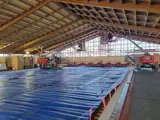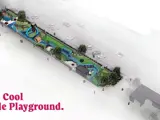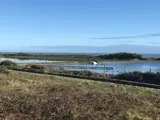Construction drawing and engineering design work for the earthquake strengthening work prepared.
In September 2016, an initial engineering report determined that the Carnegie Building was earthquake prone and in need of major seismic strengthening for it to be safe for full-time occupation as a museum and to host museum staff and visitors.
The Carnegie Building reopened to the public on Wednesday 4 December 2024, hosting the exhibition 'Kura Pounamu - Our precious stone', in conjunction with Te Papa.
Earthquake strengthening, external works and fit-out for the current exhibition are complete. Further fit out will take place in April 2025 to prepare the rooms to reopen with the museum's own collection.
The Museum reopened to the public with its own collection on 27 June 2025.
Timeline
A successful tenderer for earthquake strengthening was appointed, however work was delayed while Council applied for external funding to complete work to bring the museum’s climate and collection storage up to modern museum standards.
Funding from the Ministry of Culture and Heritage was approved.
| April | Final tender for work was awarded to Trademark Construction in April 2021 and work began immediately. |
| August | Work on pouring the concrete for the foundations started. The perimeter foundations are a critical component of the work required to raise the building to 100% NBS.
Subcontractors Shortcrete poured 67 cubic metres of concrete (supplied by Allied Concrete), and 12 tonnes of reinforcing steel went into the foundation cages. The perimeter steel reinforcing cages average 1m deep by 600mm wide spanning the complete perimeter of the buildings main and internal walls. |
| September | Work on the perimeter foundations of the Carnegie Building was completed, including structurally tying the reinforcing bars through the floor into the foundation concreting. |
| February |
80% of the construction work was completed. Contractors began working on the exterior of the building, restoring the parapets and broken windows, as well as cleaning the building |
| May |
Full installation of new reinforced concrete foundations. Concrete shear walls installed. Internal structural steel columns in the interior walls. Reinforcing the ceiling with a steel diaphragm. External upgrades to secure the brickwork, removing the parapet to install new framing, replacing coloured glass in the windows and full cleaning of the building. |
| December |
At this stage the remaining works to be undertaken were external finishes to the plasterwork at the top of the building. This includes recoating the columns on the roof. Some of the works were required to re-secure mouldings that have become detached from the building and present a safety hazard. |
| June | The parapet construction work and plastering were completed and the painting of the exterior of the building has started. The new HVAC system was completed and started up. |
| July |
The exterior painting and constructing of a new accessible entrance were completed. The perimeter fence and scaffolds were removed, and the site cleaned up. An inspection done by the structural engineer on 17 July found that there were some items that needed to be completed. A snag list was also drawn up for the contractor to work through for completion of the building. |
| August |
Minor outstanding items completed and the snag list to be worked through and signed off. All guarantee and warrantee documentation to be handed over to council during a practical completion meeting to be scheduled. |
| September |
Final exterior work has been completed. The carpark has been sealed and landscaping work finished. External lights are in place to light up the building at night. |
| February | Council resolved to implement stage II and III of the redevelopment project over the next 18 months. This involves fitting out the interior of the building to exhibit the museum's collection. |
| June | Council resolved to reduce the fit-out budget to $600,000 and consider hosting the Kura Pounamu exhibition. |
| July |
Council resolved to host the Kura Pounamu - Our treasured stone exhibition in the two front rooms of the Carnegie building. During the duration of the exhibition the remaining museum will be fitted out. |
| November |
The Council considered a proposal to increase the entry fee for non-Westland residents to the exhibition to $10. The Council resolved that there would be no entry fee for the exhibition for any visitor. |
| December |
The Kura Pounamu - Our Treasured Stone exhibition opened with a private dawn blessing on 4 December 2024. The exhibition opened to the public at 10am. |
| April | The Kura Pounamu - Our Treasured Stone exhibition closed and fitout of the permanent exhibition space began. |
| June 2025 | The Museum reopened on 27 June 2025. |
Agendas, minutes and media releases
Livestream recordings of previous meetings can be viewed on our Youtube channel.
| 22 April | Media Release - Carnegie Building new tender |
| 9 February | |
| 11 May | |
| 8 December |
| 18 July | Media release - External work on Carnegie Building nears completion |
| 22 February | |
| 30 May | |
| 20 June | |
| 25 July | |
| 26 September | |
| 28 November |



